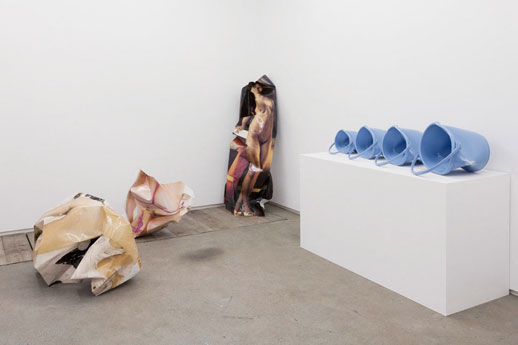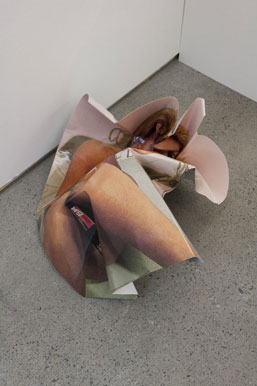Effigies of Porn, Almost Dead
Some say the era of free sex and love died in the Seventies, along with psychedelic mini-vans, scraggly red-eyed teens and a more liberal view of western sexuality. More so than the idea of guilt-free promiscuity, the pervasiveness of sexual images in modern media is the lasting stamp on us today from that time period. Yuuki Matsumura’s exhibition “Almost-Dead Sculpture” is definitely an artistic off-shoot of that western ideology, done in his unique style.
A minimalist by artistic trade, his exhibition, set in a small gallery with white walls and gray floors, make the sculptures stand out easily. At first glance, one might not think these are sculptures at all, but large sheets of crushed paper. That would be an incorrect observation. Matsumura printed life-sized images taken from the pages of old pornographic magazines onto sheet metal, which were then folded by hand to make the sculptures.
Each sculpture is crushed stylistically by Matsumura’s hand, allowing the objects to project individual messages. On one image the breasts might be abundantly clear, whilst on another all one can see are bits of naked flesh, the delicate contours of moist lips, or a sensuous eye; this all with clear knowledge as the observer that the image in its entirety originally showed a stark naked woman.

The fractured nude images create a chorus of hidden monologues, especially as it relates to our ideas and views on public displays of pornography.
 There is a playful sensibility at work here, especially if one conjures up images of schoolyard kids huddling around a horribly crushed picture of a naked woman torn from a skin mag, giggling and pointing. The choice of using images from aged adult magazines feels like an ode to a former zeitgeist; the photographic style of the pictures, the big hair and the over the top poses can speak well to the sneaky little boys in grown men; a throwback to dark rooms with muted television screens and grainy erotic movies playing on a VHS-tape, away from prying eyes.
There is a playful sensibility at work here, especially if one conjures up images of schoolyard kids huddling around a horribly crushed picture of a naked woman torn from a skin mag, giggling and pointing. The choice of using images from aged adult magazines feels like an ode to a former zeitgeist; the photographic style of the pictures, the big hair and the over the top poses can speak well to the sneaky little boys in grown men; a throwback to dark rooms with muted television screens and grainy erotic movies playing on a VHS-tape, away from prying eyes.
The pattern used in crushing these large pictures gives them obvious character. Instead of merely seeing an explicit picture, you are seeing an explicit mosaic. In some ways this works, as the pictures are molded to give a tactile variant of its intended impression. For one sculpture, the image shows a topless woman standing with her arms folded behind her neck, her back slightly arched. Matsumura folded the picture backwards at a few points, starting at the woman’s stomach, gradually exaggerating the natural arch and thus the natural pose. For the other sculptures, the position of the women affects the relative “crush” of the sculpture. Women posing with backs turned have accentuated backs or derrières, and intense facial images tailored to show the eyes more than the body. This gives a consistency to an exhibit of what appears to be a series of badly crushed pictures.
A series of identically damaged blue buckets, as well as their lids, are on display, resting on white platforms on opposite sides of the gallery area. These items and a crushed brown paper bag are the only other objects in the exhibit. I must admit the purpose of the buckets is not clear to me, as the correlation between dented empty blue buckets and pornographic material printed on sheet metal doesn’t ring any bells. However, the crushed paper bag spoke to me of privacy and secrets. Historically, liquor, sleazy magazines, special medication and other personal items are dropped into these bags to protect the privacy of the owner. This temporary home, a haven for secrets, in its crushed form connects well with the large sexual images around it. The crushed bag is itself a dying convention as risqué images and information becomes exponentially available in the age of one-click porn. In all, the gallery felt like a broken representation of our former shyness juxtaposed with broken effigies of a hyper-sexual diet. Almost dead, indeed.
Marcus Bird
Marcus Bird



